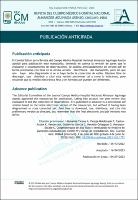| dc.contributor.author | Munarriz-Ticona, Abraham | |
| dc.contributor.author | Pareja-Maldonado, Fernando | |
| dc.contributor.author | Castro-Acuña, Katty | |
| dc.contributor.author | Vences, Miguel A. | |
| dc.contributor.author | Gutierrez-Garcia, Carla | |
| dc.contributor.author | Heredia-Orbegozo, Gabriel | |
| dc.contributor.author | Munayco-Escate, Cesar | |
| dc.date.accessioned | 2023-10-26T16:50:21Z | |
| dc.date.available | 2023-10-26T16:50:21Z | |
| dc.date.issued | 2023-07-04 | |
| dc.identifier.citation | Revista del Cuerpo Médico Hospital Nacional Almanzor Aguinaga Asenjo. 2023:16(2). | es_PE |
| dc.identifier.issn | 2227-4731 | |
| dc.identifier.uri | https://hdl.handle.net/20.500.12959/4338 | |
| dc.description.abstract | Introducción: La oxigenoterapia de alto flujo (OAF) y la ventilación no invasiva (VNI) son sistemas no invasivos que se administran post-extubación en pacientes COVID-19 para evitar la reintubación. Sin embargo, la evidencia sobre la elección de alguno de estos dispositivos no está muy clara. El objetivo fue determinar si el grupo que recibió OAF comparado con el grupo que recibió VNI se asocia a menor riesgo de reintubación en adultos con destete difícil y extubados por COVID-19. Material y métodos: Estudio cohorte retrospectivo en 206 registros de pacientes en destete difícil de ventilación mecánica en la Unidad de Cuidados Intensivos (UCI). El resultado primario fue reintubación en pacientes que fracasaron con OAF o VNI post-extubación y los resultados secundarios fueron estancia hospitalaria en UCI y mortalidad a los 90 días. Resultados: Doscientos seis pacientes cumplieron los criterios de inclusión, 102 pacientes en el grupo OAF y 104 pacientes en el grupo VNI. Durante el seguimiento de 72 horas, la tasa de reintubación en el grupo OAF fue mayor [n=24 (64,9%)] comparado con el grupo VNI [n=13 (35,1%)], mostrando en el análisis de Kaplan-Meier diferencias significativas (Log-Rank-Test p=0,005). La regresión de COX mostró mayor riesgo de reintubación en el grupo de OAF frente a VNI (HR 2,74; IC95% 1,42-5,68; p=0,007). No hubo diferencias en los días de hospitalización UCI (p=0,913) ni en mortalidad a los 90 días (Log-Rank-Test p=0,49). Conclusión: Este estudio observacional retrospectivo sugirió que la OAF frente al VNI se asoció a mayor riesgo de reintubación, pero no a mortalidad a los 90 días. | es_PE |
| dc.description.abstract | Introduction: High flow oxygen therapy (HFO) and non-invasive ventilation (NIV) are non-invasive systems that are administered post-extubation in COVID-19 patients to avoid reintubation. However,
the evidence on the choice of any of these devices is not very clear. The objective was to determine if
the group that received OAF compared to the group that received NIV is associated with a lower risk
of reintubation in adults with difficult weaning and extubated due to COVID-19. Material and
methods: Retrospective cohort study in 206 records of patients in difficult weaning from mechanical ventilation in the Intensive Care Unit (ICU). The primary outcome was reintubation in patients who
failed HFO or post-extubation NIV, and the secondary outcomes were ICU hospital stay and 90-day
mortality. Results: Two hundred and six patients met the inclusion criteria, 102 patients in the OAF
group and 104 patients in the NIV group. During the 72-h follow-up, the reintubation rate in the HFO
group was higher [n=24 (64,9%)] compared to the NIV group [n=13 (35,1%)], showing in the analysis
of Kaplan-Meier significant differences (Log-Rank-Test p=0,005). COX regression showed a higher
risk of reintubation in the HFO group compared to NIV (HR 2,74; 95%CI 1,42-5,68; p=0,007). There
were no differences in ICU hospitalization days (p=0,913) or in 90-day mortality (Log-Rank-Test
p=0,49). Conclusion: This retrospective observational study suggested that HFO versus NIV was
associated with a higher risk of reintubation, but not with 90-day mortality. | es_PE |
| dc.format | application/pdf | es_PE |
| dc.language.iso | spa | es_PE |
| dc.publisher | Seguro Social de Salud (EsSalud) | es_PE |
| dc.relation.uri | http://cmhnaaa.org.pe/ojs/index.php/rcmhnaaa/article/view/1772 | es_PE |
| dc.rights | info:eu-repo/semantics/openAccess | es_PE |
| dc.rights.uri | https://creativecommons.org/licenses/by-nc-sa/4.0/ | es_PE |
| dc.subject | Destete ventilación mecánica | es_PE |
| dc.subject | Ventilación no invasiva | es_PE |
| dc.subject | Covid-19 | es_PE |
| dc.subject | Unidad de cuidados intensivos | es_PE |
| dc.subject | Mortalidad | es_PE |
| dc.subject | Oxigenoterapia de alto flujo | es_PE |
| dc.subject | Weaning mechanical ventilation | es_PE |
| dc.subject | Non-invasive ventilation | es_PE |
| dc.subject | Intensive care unit | es_PE |
| dc.subject | Mortality | es_PE |
| dc.subject | High-flow oxygen therapy | es_PE |
| dc.title | Oxigenoterapia de alto flujo y ventilación no invasiva en pacientes extubados por COVID-19 y riesgo de reintubación | es_PE |
| dc.title.alternative | High-flow oxygen therapy and non-invasive ventilation in extubated patients with covid-19 and risk of reintubation | es_PE |
| dc.type | info:eu-repo/semantics/article | es_PE |
| dc.subject.ocde | https://purl.org/pe-repo/ocde/ford#3.02.08 | es_PE |
| dc.identifier.doi | https://doi.org/10.35434/rcmhnaaa.2023.162.1772 | |






